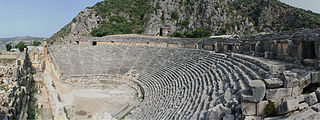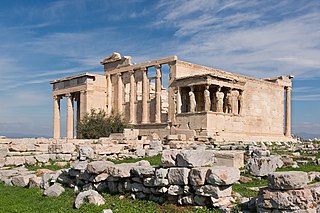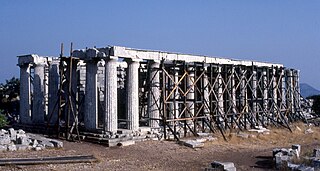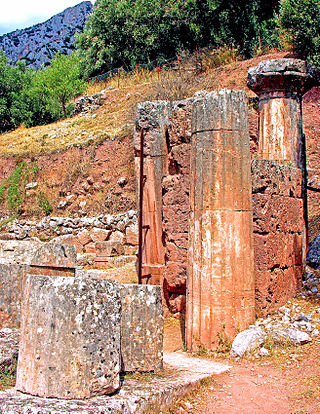
Apollo or Apollon is one of the Olympian deities in classical Greek and Roman religion and Greek and Roman mythology. Apollo has been recognized as a god of archery, music and dance, truth and prophecy, healing and diseases, the Sun and light, poetry, and more. One of the most important and complex of the Greek gods, he is the son of Zeus and Leto, and the twin brother of Artemis, goddess of the hunt. He is considered to be the most beautiful god and is represented as the ideal of the kouros. Apollo is known in Greek-influenced Etruscan mythology as Apulu.

The Acropolis of Athens is an ancient citadel located on a rocky outcrop above the city of Athens, Greece, and contains the remains of several ancient buildings of great architectural and historical significance, the most famous being the Parthenon. The word Acropolis is from the Greek words ἄκρον and πόλις. The term acropolis is generic and there are many other acropoleis in Greece. During ancient times the Acropolis of Athens was also more properly known as Cecropia, after the legendary serpent-man Cecrops, the supposed first Athenian king.

Delphi, in legend previously called Pytho (Πυθώ), was an ancient sacred precinct and the seat of Pythia, the major oracle who was consulted about important decisions throughout the ancient classical world. The ancient Greeks considered the centre of the world to be in Delphi, marked by the stone monument known as the Omphalos of Delphi (navel).

The Parthenon is a former temple on the Athenian Acropolis, Greece, that was dedicated to the goddess Athena during the fifth century BC. Its decorative sculptures are considered some of the high points of classical Greek art, an enduring symbol of Ancient Greece, democracy and Western civilization.

Myra was a Lycian, then ancient Greek, then Greco-Roman, then Byzantine Greek, then Ottoman town in Lycia, which became the small Turkish town of Kale, renamed Demre in 2005, in the present-day Antalya Province of Turkey. In 1923, its Greek inhabitants had been required to leave by the population exchange between Greece and Turkey, at which time its church was finally abandoned. It was founded on the river Myros, in the fertile alluvial plain between Alaca Dağ, the Massikytos range and the Aegean Sea.

Side is a city on the southern Mediterranean coast of Turkey. It includes the modern resort town and the ruins of the ancient city of Side, one of the best-known classical sites in the country. Modern Side is a neighbourhood of the municipality and district of Manavgat, Antalya Province, Turkey. Its population is 14,527 (2022). Before the 2013 reorganisation, it was a town (belde). It lies near Manavgat, 78 km from Antalya.

The Erechtheion or Temple of Athena Polias is an ancient Greek Ionic temple-telesterion on the north side of the Acropolis, Athens, which was primarily dedicated to the goddess Athena. The building, made to house the statue of Athena Polias, has in modern scholarship been called the Erechtheion in the belief that Pausanias' description of the Erechtheion applies to this building. However, whether the Erechtheion referred to by Pausanias is indeed the Ionic temple or an entirely different building has become a point of contention in recent decades.

Lindos is an archaeological site, a fishing village and a former municipality on the island of Rhodes, in the Dodecanese, Greece. Since the 2011 local government reform it is part of the municipality Rhodes, of which it is a municipal unit. The municipal unit has an area of 178.9 km2. It lies on the east coast of the island. It is about 40 km south of the city of Rhodes and its fine beaches make it a popular tourist and holiday destination. Lindos is situated in a large bay and faces the fishing village and small resort of Charaki.

A portico is a porch leading to the entrance of a building, or extended as a colonnade, with a roof structure over a walkway, supported by columns or enclosed by walls. This idea was widely used in ancient Greece and has influenced many cultures, including most Western cultures.

Patara was an ancient and flourishing maritime and commercial city, and for a period the capital of Lycia. The site is located on the Turkish coast near to the village of Gelemiş, in Antalya Province.

Bassae is an archaeological site in Oichalia, a municipality in the northeastern part of Messenia, Greece. In classical antiquity, it was part of Arcadia. Bassae lies near the village of Skliros, northeast of Figaleia, south of Andritsaina and west of Megalopolis. It is famous for the well-preserved mid- to late-5th century BC Temple of Apollo Epicurius.

Lagina or Laginia (Λαγινία) was a town and religious centre in ancient Caria. It contained an important monumental temple of Hecate, at which great festivals were celebrated every year. For most of antiquity, it was a part of the territory of Stratonicea.

Hierapolis was originally a Phrygian cult centre of the Anatolian mother goddess of Cybele and later a Greek city. Its location was centred upon the remarkable and copious hot springs in classical Phrygia in southwestern Anatolia. Its extensive remains are adjacent to modern Pamukkale in Turkey.

The Temple of Apollo Palatinus, sometimes called the Temple of Actian Apollo, was a temple to the god Apollo in Rome, constructed on the Palatine Hill on the initiative of Augustus between 36 and 28 BCE. It was the first temple to Apollo within the city's ceremonial boundaries and the second of four temples constructed by Augustus. According to tradition, the site for the temple was chosen when it was struck by lightning, which was interpreted as a divine portent. Augustan writers situated the temple next to Augustus's personal residence, which has been controversially identified as the structure known as the domus Augusti.

The Antalya Museum or Antalya Archeological Museum is one of Turkey's largest museums, located in Konyaaltı, Antalya. It includes 13 exhibition halls and an open air gallery. It covers an area of 7,000 m2 (75,000 sq ft) and 5000 works of art are exhibited. In addition a further 25,000–30,000 artifacts which cannot be displayed are in storage. As a museum exhibiting examples of works, which illuminate the history of the Mediterranean and Pamphylia regions in Anatolia, Antalya Museum is one of the most important of Turkey's museums. The Museum won the "European Council Special Prize" in 1988.

The Acropolis of Rhodes is the acropolis, or upper town, of ancient Rhodes dating from the 5th century BC and located 3 kilometers SW from the centre of the modern city. Situated on Monte Smith overlooking the west coast of the island, the archaeological site includes some of the most important monuments in the ancient city, such as the Temple of Athena Polias and Zeus Polieus and the Temple of Apollo, below which are a stadium, an odeon and a gymnasium. Unlike other acropoleis, no walled citadel was built here.

Rhodiapolis, also known as Rhodia (Ῥοδία) and Rhodiopolis (Ῥοδιόπολις), was a city in ancient Lycia. Today it is located on a hill northwest of the modern town Kumluca in Antalya Province, Turkey.

The Temple of Athena Pronaia was a temple at the ancient site of Delphi, in the Sanctuary of Athena Pronaia, a group of buildings comprising temples and treasuries as well as the famous Tholos of Delphi. There were in fact three successive temples built at the site. The earlier temples (38°28′49″N22°30′30″E), referred to as A and B, were built in the 7th and 6th centuries BC respectively and were made of porous stone; a third temple (38°28′49″N22°30′28″E) was built of limestone in the 4th century BC, although it is not certain that it actually was dedicated to Athena this time.

Jale İnan was a Turkish archaeologist, and she is considered to be the first Turkish woman to have been active in the discipline. She led excavations in Perga and Side which resulted in the expansion of the Antalya Museum. Her restoration work on the Temple of Apollo in Side was noted for its significance to Turkish heritage. Her scientific work on the "Weary Hercules" statue in the collections of the Museum of Fine Arts, Boston formed the legal basis for return of the bust of the statue to the Antalya Museum to be reunited with the statue's base. The Antalya Women's Museum has an annual award in her honour which recognizes the woman of the year.

The Temple of Jupiter is a ruined Roman temple in Silifke, Turkey. It was built in the 2nd century, and presently one column still stands.






















